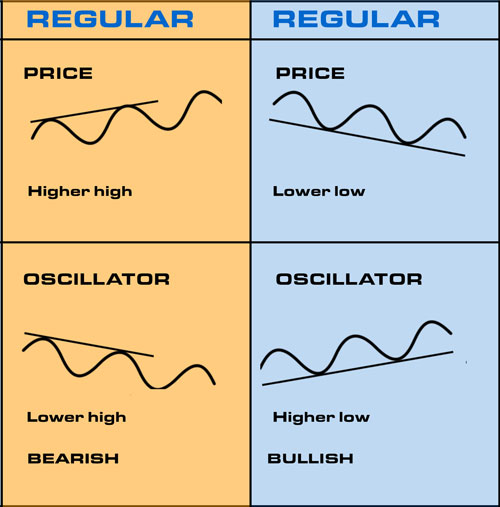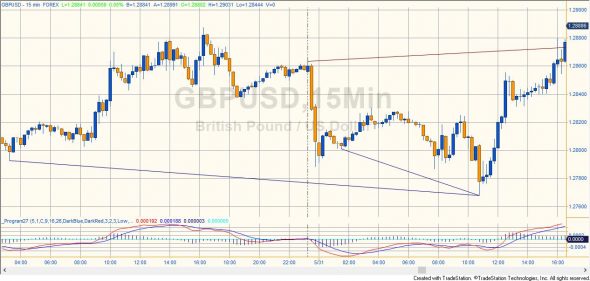Divergence at Markplex.com
I am often asked about the differences between all the many TradeStation EasyLanguage divergence based tutorials and programs on this site. The following are some notes to explain some of the features of the various programs. I have also listed all the divergence related programs/tutorials and created a table that compares the features below.

Simple
In tutorial 4, the program searches for low pivots (valleys) in the stochastic and assumes the price pivots occur at the same time. Having found a stochastic pivot it uses the price values that occur on the same bar as the pivot. Of course, oscillator pivots and price pivots do not always (or often) occur on the same bar. This tutorial is very simple and represents a good place to start when learning about programming EasyLanguage. In the table below I indicated this programming construct as “Oscillator and price pivots can be on different bars.”
Intermediate
In tutorial 26 and all later programs and tutorials, the program looks for pivots in both price AND the oscillator. These pivots must occur within a user input number of bars of each other to be considered ‘matching’ pivots.
More advanced
The major difference between program 27 and later programs and tutorial 26 is that program 27 stores previous pivot information in an array (i.e. it keeps a records of the last several pivots). Each time a new pivot pair is discovered, previous pivots are compared with it. Tutorial 26 only determines whether there is divergence between the most recent two pivot pairs.

There are many other differences, some which are highlighted in the table below. For example, program 62 is an indicator, whereas program 66 is a function (in TradeStation parlance, this is a program that has to be called from another program) although I include an example TradeStation showme study of how to call the program 66 function.
Tutorials which include divergence calculations
Tutorial 4 | Divergence between a stochastic indicator and price
Tutorial 26 | An improved stochastic - price divergence indicator
Tutorial 37 | A show me study to show divergence between price and stochastic
Tutorial 75 | Add a divergence component to the CCI trend line break program
Programs which include divergence calculations
Program 9 | A smoothed, low-lag Commodity Channel Index (CCI) indicator
Program 10 | An enhanced smoothed, low-lag CCI indicator
Program 11 | Enhanced smoothed, low-lag CCI indicator--EXTRA FEATURES
Program 18 | CCI divergence strategy (and smoothed CCI indicator)
Program 24 | CCI hidden or reverse divergence
Program 27 | MACD divergence for charts, scanner and RadarScreen
Program 28 | Stochastic divergence for charts, scanner and RadarScreen
Program 30 | True Strength Index (TSI) divergence
Program 42 | RSI Divergence Indicator and Showme Study
Program 60 | Stochastic of RSI smoothed plot and divergence
Program 62 | Stochastic, RSI, TSI, CCI, MACD, and stochastic RSI divergence
Program 66 | Flexible divergence function
Comparison of all the programs
| Oscillator analyzed | Works on sub minute bars (e.g seconds or tick bars) | Multicharts compatible | Oscillator and price pivots can be on different bars | Analyzes previous and additional pivots | Type of program | Price | |
|---|---|---|---|---|---|---|---|
| Tutorial 4 | Stochastic | No | Yes | Yes | No | Indicator | $19.95 |
| Tutorial 26 | Stochastic | No | Yes | Yes | No | Indicator | $14.95 |
| Tutorial 37 | Stochastic | No | Yes | Yes | No | Showme | $14.95 |
| Tutorial 75 | CCI | No | Yes | Yes | No | Indicator | $49.95 |
| Program 9 | CCI | No | Yes | Yes | No | Indicator | $44.95 |
| Program 10 | CCI | No | Yes | Yes | No | Indicator | $54.95 |
| Program 11 | CCI | No | Yes | Yes | No | Indicator | $69.95 |
| Program 18 | CCI | No | Yes | Yes | No | Strategy Indicator | $225.00 |
| Program 24 | CCI | No | Yes | Yes | No | Indicator | $69.95 |
| Program 27 | MACD | No | Yes | Yes | Yes | Indicator | $129.95 |
| Program 28 | Stochastic | No | Yes | Yes | Yes | Indicator | $95.95 |
| Program 30 | TSI | No | Yes | Yes | Yes | Indicator | $97.95 |
| Program 42 | RSI | No | Yes | Yes | Yes | Indicator Showme study | $79.95 |
| Program 60 | Stochastic RSI | No | Yes | Yes | Yes | Indicator Showme | $49.95 |
| Program 62 | Stochastic RSI TSI CCI MACD Stochastic RSI | Yes | No | Yes | Yes | Indicator | Protected $145.00 Unprotected $245.00 |
| Program 66 | Stochastic RSI TSI CCI MACD Stochastic RSI | Yes | Yes | Yes | Yes | Function Showme study | $175.00 |
Please let me know if you noticed any errors on this page or if you have further questions.

